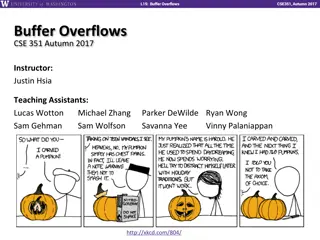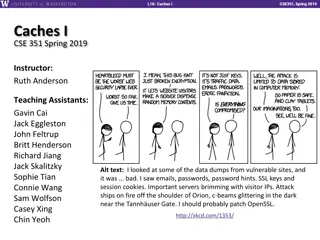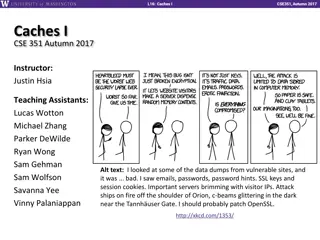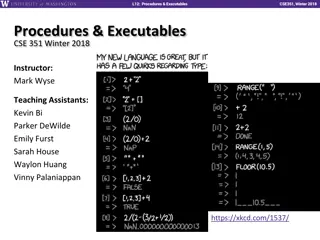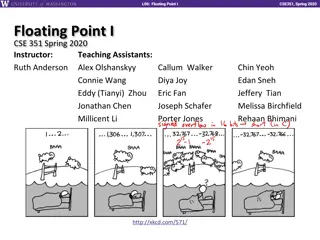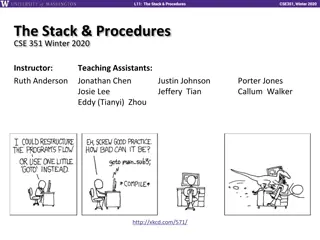
Cache in Computer Systems
Explore the concept of cache memory in computer systems, discussing types of caches, cache hierarchies, write policies, and cache examples. Learn about cache hits, misses, write strategies, and the role of cache in enhancing system performance.
Download Presentation

Please find below an Image/Link to download the presentation.
The content on the website is provided AS IS for your information and personal use only. It may not be sold, licensed, or shared on other websites without obtaining consent from the author. If you encounter any issues during the download, it is possible that the publisher has removed the file from their server.
You are allowed to download the files provided on this website for personal or commercial use, subject to the condition that they are used lawfully. All files are the property of their respective owners.
The content on the website is provided AS IS for your information and personal use only. It may not be sold, licensed, or shared on other websites without obtaining consent from the author.
E N D
Presentation Transcript
L01: Intro, Combinational Logic L18: Cache Example, System Control Flow CSE369, Autumn 2016 CSE351, Winter 2017 Cache Example, System Control Flow CSE 351 Winter 2017 http://xkcd.com/292/
L01: Intro, Combinational Logic L18: Cache Example, System Control Flow CSE369, Autumn 2016 CSE351, Winter 2017 Administrivia Lab 3 due Monday Lab 4 released Monday HW 3 released Phew! Remember to do readings and practice problems on the book 2
L01: Intro, Combinational Logic L18: Cache Example, System Control Flow CSE369, Autumn 2016 CSE351, Winter 2017 Core i7: Associativity Processor package Core 0 Core 3 Block/line size: 64 bytes for all Regs Regs L1 i-cache and d-cache: 32 KiB, 8-way, Access: 4 cycles L1 L1 L1 L1 d-cache i-cache d-cache i-cache L2 unified cache: 256 KiB, 8-way, Access: 11 cycles L2 unified cache L2 unified cache L3 unified cache: 8 MiB, 16-way, Access: 30-40 cycles L3 unified cache (shared by all cores) slower, but more likely to hit Main memory 3
L01: Intro, Combinational Logic L18: Cache Example, System Control Flow CSE369, Autumn 2016 CSE351, Winter 2017 What about writes? Multiple copies of data exist: L1, L2, possibly L3, main memory What to do on a write-hit? Write-through: write immediately to memory and all caches in-between Write-back: defer write to memory until line is evicted (replaced) Must track which cache lines have been modified ( dirty bit ) What to do on a write-miss? Write-allocate: ( fetch on write ) load into cache, update line in cache Good if more writes or reads to the location follow, example? No-write-allocate: ( write around ) just write immediately to memory Typical caches: Write-back + Write-allocate, usually Write-through + No-write-allocate, occasionally 4
L01: Intro, Combinational Logic L18: Cache Example, System Control Flow CSE369, Autumn 2016 CSE351, Winter 2017 Write-back, write-allocate example Contents of memory stored at address G Cache 0xBEEF G 0 dirty bit tag (there is only one set in this tiny cache, so the tag is the entire block address!) In this example we are sort of ignoring block offsets. Here a block holds 2 bytes (16 bits, 4 hex digits). F Memory 0xCAFE 0xBEEF G Normally a block would be much bigger and thus there would be multiple items per block. While only one item in that block would be written at a time, the entire line would be brought into cache. 5
L01: Intro, Combinational Logic L18: Cache Example, System Control Flow CSE369, Autumn 2016 CSE351, Winter 2017 Write-back, write-allocate example mov 0xFACE, F Cache 0xBEEF G 0 dirty bit F Memory 0xCAFE 0xBEEF G 6
L01: Intro, Combinational Logic L18: Cache Example, System Control Flow CSE369, Autumn 2016 CSE351, Winter 2017 Write-back, write-allocate example mov 0xFACE, F Cache 0xBEEF 0xCAFE 0xCAFE U F 0 0 dirty bit Step 1: Bring F into cache F Memory 0xCAFE 0xBEEF G 7
L01: Intro, Combinational Logic L18: Cache Example, System Control Flow CSE369, Autumn 2016 CSE351, Winter 2017 Write-back, write-allocate example mov 0xFACE, F Cache 0xBEEF 0xCAFE 0xFACE U F 0 1 dirty bit Step 2: Write 0xFACE to cache only and set dirty bit F Memory 0xCAFE 0xBEEF G 8
L01: Intro, Combinational Logic L18: Cache Example, System Control Flow CSE369, Autumn 2016 CSE351, Winter 2017 Write-back, write-allocate example mov 0xFACE, F mov 0xFEED, F Cache 0xBEEF 0xCAFE 0xFACE U F 0 1 dirty bit Write hit! Write 0xFEED to cache only F Memory 0xCAFE 0xBEEF G 9
L01: Intro, Combinational Logic L18: Cache Example, System Control Flow CSE369, Autumn 2016 CSE351, Winter 2017 Write-back, write-allocate example mov 0xFACE, F mov G,%rax mov 0xFEED, F Cache 0xBEEF 0xCAFE 0xFEED U F 0 1 dirty bit F Memory 0xCAFE 0xBEEF G 10
L01: Intro, Combinational Logic L18: Cache Example, System Control Flow CSE369, Autumn 2016 CSE351, Winter 2017 Write-back, write-allocate example mov 0xFACE, F mov G,%rax mov 0xFEED, F Cache 0xBEEF G 0 dirty bit 1. Write F back to memory since it is dirty 2. Bring G into the cache so we can copy it into %rax F Memory 0xFEED 0xBEEF G 11
L01: Intro, Combinational Logic L18: Cache Example, System Control Flow CSE369, Autumn 2016 CSE351, Winter 2017 Optimizations for the Memory Hierarchy Write code that has locality! Spatial: access data contiguously Temporal: make sure access to the same data is not too far apart in time How can you achieve locality? Adjust memory accesses in code (software) to improve miss rate (MR) Requires knowledge of bothhow caches work as well as your system s parameters Proper choice of algorithm Loop transformations 12
L01: Intro, Combinational Logic L18: Cache Example, System Control Flow CSE369, Autumn 2016 CSE351, Winter 2017 Example: Matrix Multiplication C A B cij = ai* b*j
L01: Intro, Combinational Logic L18: Cache Example, System Control Flow CSE369, Autumn 2016 CSE351, Winter 2017 Matrices in Memory How do cache blocks fit into this scheme? Row major matrix in memory: Cache blocks COLUMN of matrix (blue) is spread among cache blocks shown in red
L01: Intro, Combinational Logic L18: Cache Example, System Control Flow CSE369, Autumn 2016 CSE351, Winter 2017 Na ve Matrix Multiply # move along rows of A for (i = 0; i < n; i++) # move along columns of B for (j = 0; j < n; j++) # EACH k loop reads row of A, col of B # Also read & write c(i,j) n times for (k = 0; k < n; k++) c[i*n+j] += a[i*n+k] * b[k*n+j]; C(i,j) C(i,j) A(i,:) = + B(:,j)
L01: Intro, Combinational Logic L18: Cache Example, System Control Flow CSE369, Autumn 2016 CSE351, Winter 2017 Ignoring matrix c Cache Miss Analysis (Na ve) Scenario Parameters: Square matrix (? ?), elements are doubles Cache block size K = 64 B = 8 doubles Cache size C ? (much smaller than ?) ?/8 misses First iteration: ? misses = ? 8+ ? =9? 8 misses Afterwards in cache: (schematic) = 8 doubles wide
L01: Intro, Combinational Logic L18: Cache Example, System Control Flow CSE369, Autumn 2016 CSE351, Winter 2017 Ignoring matrix c Cache Miss Analysis (Na ve) Scenario Parameters: Square matrix (? ?), elements are doubles Cache block size K = 64 B = 8 doubles Cache size C ? (much smaller than ?) Other iterations: Again: ? 8+ ? =9? = 8 misses 8 wide Total misses: 9? 8 ?2=9 8?3 once per element
L01: Intro, Combinational Logic L18: Cache Example, System Control Flow CSE369, Autumn 2016 CSE351, Winter 2017 Linear Algebra to the Rescue (1) Can get the same result of a matrix multiplication by splitting the matrices into smaller submatrices (matrix blocks ) For example, multiply two 4 4 matrices:
L01: Intro, Combinational Logic L18: Cache Example, System Control Flow CSE369, Autumn 2016 CSE351, Winter 2017 Linear Algebra to the Rescue (2) C11 C12 C13 C14 A11 A12 A13 A14 B11 B12 B13 B14 C21 C22 C23 C24 A21 A22 A23 A24 B21 B22 B23 B24 C31 C32 C43 C34 A31 A32 A33 A34 B32 B32 B33 B34 C41 C42 C43 C44 A41 A42 A43 A144 B41 B42 B43 B44 Matrices of size ? ?, split into 4 blocks of size ? (?=4?) C22 = A21B12 + A22B22 + A23B32 + A24B42 = k A2k*Bk2 Multiplication operates on small block matrices Choose size so that they fit in the cache! This technique called cache blocking
L01: Intro, Combinational Logic L18: Cache Example, System Control Flow CSE369, Autumn 2016 CSE351, Winter 2017 Blocked Matrix Multiply Blocked version of the na ve algorithm: # move by rxr BLOCKS now for (i = 0; i < n; i += r) for (j = 0; j < n; j += r) for (k = 0; k < n; k += r) # block matrix multiplication for (ib = i; ib < i+r; ib++) for (jb = j; jb < j+r; jb++) for (kb = k; kb < k+r; kb++) c[ib*n+jb] += a[ib*n+kb]*b[kb*n+jb]; ? = block matrix size (assume ? divides ? evenly)
L01: Intro, Combinational Logic L18: Cache Example, System Control Flow CSE369, Autumn 2016 CSE351, Winter 2017 Ignoring matrix c Cache Miss Analysis (Blocked) Scenario Parameters: Cache block size K = 64 B = 8 doubles Cache size C ? (much smaller than ?) Three blocks (? ?) fit into cache: 3?2< ? ?/? blocks ?2elements per block, 8 per cache block First (block) iteration: ?2/8 misses per block 2?/? ?2/8 = ??/4 = ?/? blocks in row and column Afterwards in cache (schematic) =
L01: Intro, Combinational Logic L18: Cache Example, System Control Flow CSE369, Autumn 2016 CSE351, Winter 2017 Ignoring matrix c Cache Miss Analysis (Blocked) Scenario Parameters: Cache block size K = 64 B = 8 doubles Cache size C ? (much smaller than ?) Three blocks (? ?) fit into cache: 3?2< ? ?/? blocks Other (block) iterations: Same as first iteration 2?/? ?2/8 = ??/4 = Total misses: ??/4 (?/?)2= ?3/(4?)
L01: Intro, Combinational Logic L18: Cache Example, System Control Flow CSE369, Autumn 2016 CSE351, Winter 2017 Matrix Multiply Summary (9/8) ?3 1/(4?) ?3 Na ve: Blocked: If ? = 8, difference is 4*8 * 9/8 = 36x If ? = 16, difference is 4*16 * 9/8 = 72x Blocking optimization only works if the blocks fit in the cache Suggests largest possible block size up to limit 3?2 ? Matrix multiplication has inherent temporal locality: Input data: 3?2, computation 2?3 Every array element used ?(?) times! But program has to be written properly 23
L01: Intro, Combinational Logic L18: Cache Example, System Control Flow CSE369, Autumn 2016 CSE351, Winter 2017 Cache-Friendly Code Programmer can optimize for cache performance How data structures are organized How data are accessed Nested loop structure Blocking is a general technique All systems favor cache-friendly code Getting absolute optimum performance is very platform specific Cache size, cache block size, associativity, etc. Can get most of the advantage with generic code Keep working set reasonably small (temporal locality) Use small strides (spatial locality) Focus on inner loop code 25
L01: Intro, Combinational Logic L18: Cache Example, System Control Flow CSE369, Autumn 2016 CSE351, Winter 2017 Core i7 Haswell 2.1 GHz 32 KB L1 d-cache 256 KB L2 cache 8 MB L3 cache 64 B block size The Memory Mountain Aggressive prefetching 16000 14000 L1 Read throughput (MB/s) 12000 10000 8000 Ridges of temporal locality L2 6000 4000 L3 2000 Slopes of spatial locality 0 32k s1 128k s3 Mem 512k s5 2m s7 8m s9 Stride (x8 bytes) Size (bytes) 32m s11 128m 26
L01: Intro, Combinational Logic L18: Cache Example, System Control Flow CSE369, Autumn 2016 CSE351, Winter 2017 Learning About Your Machine Linux: lscpu ls /sys/devices/system/cpu/cpu0/cache/index0/ Ex: cat /sys/devices/system/cpu/cpu0/cache/index*/size cat/proc/cpuinfo|grepcache|sort|uniq Windows: wmic memcache get <query> (all values in KB) Ex: wmic memcache get MaxCacheSize Modern processor specs: http://www.7-cpu.com/
L01: Intro, Combinational Logic L18: Cache Example, System Control Flow CSE369, Autumn 2016 CSE351, Winter 2017 Data & addressing Integers & floats Machine code & C x86 assembly Procedures & stacks Arrays & structs Memory & caches Processes Virtual memory Memory allocation Java vs. C Roadmap C: Java: Car c = new Car(); c.setMiles(100); c.setGals(17); float mpg = c.getMPG(); car *c = malloc(sizeof(car)); c->miles = 100; c->gals = 17; float mpg = get_mpg(c); free(c); Assembly language: get_mpg: pushq %rbp movq %rsp, %rbp ... popq %rbp ret OS: Machine code: 0111010000011000 100011010000010000000010 1000100111000010 110000011111101000011111 Computer system: 28
L01: Intro, Combinational Logic L18: Cache Example, System Control Flow CSE369, Autumn 2016 CSE351, Winter 2017 Leading Up to Processes System Control Flow Control flow Exceptional control flow Asynchronous exceptions (interrupts) Synchronous exceptions (traps & faults) 29
L01: Intro, Combinational Logic L18: Cache Example, System Control Flow CSE369, Autumn 2016 CSE351, Winter 2017 Control Flow So far:we ve seen how the flow of control changes as a single program executes Reality: multiple programs running concurrently How does control flow across the many components of the system? In particular: More programs running than CPUs Exceptional control flow is basic mechanism used for: Transferring control between processes and OS Handling I/O and virtual memory within the OS Implementing multi-process apps like shells and web servers Implementing concurrency 30
L01: Intro, Combinational Logic L18: Cache Example, System Control Flow CSE369, Autumn 2016 CSE351, Winter 2017 Control Flow Processors do only one thing: From startup to shutdown, a CPU simply reads and executes (interprets) a sequence of instructions, one at a time This sequence is the CPU s control flow (or flow of control) Physical control flow <startup> instr1 instr2 instr3 instrn <shutdown> time 31
L01: Intro, Combinational Logic L18: Cache Example, System Control Flow CSE369, Autumn 2016 CSE351, Winter 2017 Altering the Control Flow Up to now: two ways to change control flow: Jumps (conditional and unconditional) Call and return Both react to changes in program state Processor also needs to react to changes in system state Unix/Linux user hits Ctrl-C at the keyboard User clicks on a different application s window on the screen Data arrives from a disk or a network adapter Instruction divides by zero System timer expires Can jumps and procedure calls achieve this? No the system needs mechanisms for exceptional control flow! 32
L01: Intro, Combinational Logic L18: Cache Example, System Control Flow CSE369, Autumn 2016 CSE351, Winter 2017 Exceptional Control Flow Exists at all levels of a computer system Low level mechanisms Exceptions Change in processor s control flow in response to a system event (i.e., change in system state, user-generated interrupt, bugs) Implemented using a combination of hardware and OS software Higher level mechanisms Process context switch Implemented by OS software and hardware timer Signals Implemented by OS software We won t cover these see CSE451 and CSE/EE474 34
L01: Intro, Combinational Logic L18: Cache Example, System Control Flow CSE369, Autumn 2016 CSE351, Winter 2017 Exceptions An exception is transfer of control to the operating system (OS) kernel in response to some event(i.e., change in processor state) Kernel is the memory-resident part of the OS Examples: division by 0, page fault, I/O request completes, Ctrl-C User Code OS Kernel Code exception event current_instr next_instr exception processing by exception handler, then: return to current_instr, return to next_instr, OR abort How does the system know where to jump to in the OS?
L01: Intro, Combinational Logic L18: Cache Example, System Control Flow CSE369, Autumn 2016 CSE351, Winter 2017 Exception Table A jump table for exceptions (also called Interrupt Vector Table) Each type of event has a unique exception number ? ?= index into exception table (a.k.a interrupt vector) Handler ? is called each time exception ? occurs Exception Table code for exception handler 0 code for exception handler 1 0 1 2 code for exception handler 2 ... ... n-1 code for exception handler n-1 Exception numbers 36
L01: Intro, Combinational Logic L18: Cache Example, System Control Flow CSE369, Autumn 2016 CSE351, Winter 2017 Exception Table (Excerpt) Exception Number Description Exception Class 0 Divide error Fault 13 General protection fault Fault 14 Page fault Fault 18 Machine check Abort 32-255 OS-defined Interrupt or trap 37
L01: Intro, Combinational Logic L18: Cache Example, System Control Flow CSE369, Autumn 2016 CSE351, Winter 2017 Leading Up to Processes System Control Flow Control flow Exceptional control flow Asynchronous exceptions (interrupts) Synchronous exceptions (traps & faults) 38
L01: Intro, Combinational Logic L18: Cache Example, System Control Flow CSE369, Autumn 2016 CSE351, Winter 2017 Asynchronous Exceptions (Interrupts) Caused by events external to the processor Indicated by setting the processor s interrupt pin(s) (wire into CPU) After interrupt handler runs, the handler returns to next instruction Examples: I/O interrupts Hitting Ctrl-C on the keyboard Clicking a mouse button or tapping a touchscreen Arrival of a packet from a network Arrival of data from a disk Timer interrupt Every few ms, an external timer chip triggers an interrupt Used by the OS kernel to take back control from user programs 39
L01: Intro, Combinational Logic L18: Cache Example, System Control Flow CSE369, Autumn 2016 CSE351, Winter 2017 Synchronous Exceptions Caused by events that occur as a result of executing an instruction: Traps Intentional: transfer control to OS to perform some function Examples: system calls, breakpoint traps, special instructions Returns control to next instruction Faults Unintentional but possibly recoverable Examples: page faults, segment protection faults, integer divide-by-zero exceptions Either re-executes faulting ( current ) instruction or aborts Aborts Unintentional and unrecoverable Examples: parity error, machine check (hardware failure detected) Aborts current program 40
L01: Intro, Combinational Logic L18: Cache Example, System Control Flow CSE369, Autumn 2016 CSE351, Winter 2017 System Calls Each system call has a unique ID number Examples for Linux on x86-64: Number Name read write open close stat fork execve _exit kill Description 0 Read file 1 Write file 2 Open file 3 Close file 4 Get info about file 57 Create process 59 Execute a program 60 Terminate process 62 Send signal to process 41
L01: Intro, Combinational Logic L18: Cache Example, System Control Flow CSE369, Autumn 2016 CSE351, Winter 2017 Traps Example: Opening File User calls open(filename, options) Calls __open function, which invokes system call instruction syscall 00000000000e5d70 <__open>: ... e5d79: b8 02 00 00 00 mov e5d7e: 0f 05 syscall # return value in %rax e5d80: 48 3d 01 f0 ff ff cmp ... e5dfa: c3 retq $0x2,%eax # open is syscall 2 $0xfffffffffffff001,%rax User code OS Kernel code %raxcontains syscall number Other arguments in %rdi, %rsi, %rdx, %r10, %r8, %r9 Exception syscall cmp Return value in %rax Open file Negative value is an error corresponding to negative errno Returns
L01: Intro, Combinational Logic L18: Cache Example, System Control Flow CSE369, Autumn 2016 CSE351, Winter 2017 Fault Example: Page Fault int a[1000]; int main () { a[500] = 13; } User writes to memory location That portion (page) of user s memory is currently on disk 80483b7: c7 05 10 9d 04 08 0d movl $0xd,0x8049d10 User code OS Kernel code handle_page_fault: exception: page fault movl Create page and load into memory returns Page fault handler must load page into physical memory Returns to faulting instruction: mov is executed again! Successful on second try
L01: Intro, Combinational Logic L18: Cache Example, System Control Flow CSE369, Autumn 2016 CSE351, Winter 2017 Fault Example: Invalid Memory Reference int a[1000]; int main() { a[5000] = 13; } 80483b7: c7 05 60 e3 04 08 0d movl $0xd,0x804e360 User Process OS exception: page fault handle_page_fault: movl detect invalid address signal process Page fault handler detects invalid address Sends SIGSEGV signal to user process User process exits with segmentation fault 44
L01: Intro, Combinational Logic L18: Cache Example, System Control Flow CSE369, Autumn 2016 CSE351, Winter 2017 Summary Exceptions Events that require non-standard control flow Generated externally (interrupts) or internally (traps and faults) After an exception is handled, one of three things may happen: Re-execute the current instruction Resume execution with the next instruction Abort the process that caused the exception 45

